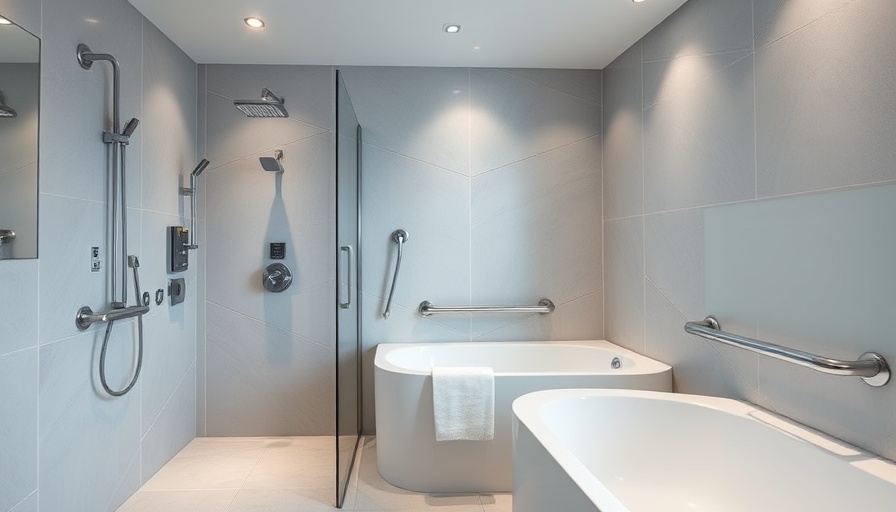
Accessibility in Bathroom Design: A Crucial Perspective
As we navigate through the evolving landscape of home renovations, enhancing bathroom accessibility resonates deeply with many homeowners, particularly those supporting elderly parents or individuals with disabilities. Renovating a bathroom to accommodate diverse needs is not just about compliance with regulations; it’s about creating a nurturing environment where everyone feels welcome and capable.
At the heart of Ocean County, we’ve encountered inspiring stories from families who have transformed their bathrooms into accessible havens. These renovations symbolize hope, independence, and dignity, reminding us that with the right expertise, aging in place or living with disabilities doesn't have to mean sacrificing quality of life.
Innovative Case Studies: Real-Life Transformations
Within the community of Ocean County, several remarkable renovation projects have collectively sparked change, combining elegance with functionality. One significant transformation involved a family grappling with a sudden mobility challenge. Here, the design team prioritized an open layout that allowed for seamless wheelchair navigation. They integrated a barrier-free shower, strategically placed grab bars, and a sleek non-slip flooring solution to ensure safety. Most importantly, the design maintains a contemporary style that doesn’t scream "accessible" but rather seamlessly integrates into a modern aesthetic.
Another standout project featured eco-conscious homeowners embracing both sustainability and accessibility. By choosing modern materials and integrating technologies like motion-sensor lights and adjustable temperature faucets, they highlighted that accessibility can be both innovative and environmentally responsible. Such case studies not only validate the necessity of thoughtful bathroom design but also inspire boldly customized living spaces that cater to individual needs.
Top Features of an Accessible Bathroom: Empowering Design Choices
Several key elements make a bathroom both functional and safe. Open space is vital for freely maneuvering; a layout that supports a minimum diameter of 5 feet can significantly enhance user independence. Additionally, fixtures should prioritize safety. Think robust grab bars placed near crucial areas, non-slip surfaces to prevent accidents, and ergonomically designed lever faucets that can be operated with minimal dexterity.
Moreover, it’s essential to ensure that bathrooms are equipped with adequate lighting, showcasing the importance of a well-lit environment which makes all activities—from showering to applying makeup—safer and easier.
The Importance of Community Support in Renovations
It cannot be overstated how vital local expertise and community support are in championing such projects. Local contractors are often more attuned to the specific needs and challenges of the community. They understand local building codes and regulations and can offer realistic insights into what practical modifications will look like. Engaging with local businesses promotes community bonds while also ensuring that renovations meet crucial safety standards for all.
The ongoing dialogue in Ocean County about improving accessibility has not just sparked transformations within homes but has inspired a broader movement. This growing awareness is paramount; it not only enlightens families about possible renovations but also reminds us that homes, the sanctuaries of our lives, must cater to all of life’s stages.
Embracing Change: The Emotional Journey of Home Renovation
Embarking on a renovation project often evokes a mix of emotions. Many families grapple with the bittersweet transition as they adapt to new realities surrounding mobility challenges. However, embracing these changes can lead to poignant moments of empowerment. The act of modifying a space can symbolize resilience and the fight for independence.
For instance, a recent homeowner shared how their remodeled bathroom became a source of renewed confidence, as the once-difficult daily tasks turned into enjoyable experiences. Heartwarming testimonies like these shed light on the human aspect of renovations; every installed grab bar or widened doorway served a dual purpose, not only facilitating easier access but affirming that every resident deserves a beautiful, functional home.
Getting Started: Resources for Accessible Bathroom Renovations
If you are contemplating an accessible bathroom renovation, numerous resources are available to guide you in your journey. Connecting with local contractors who specialize in accessibility can provide insights tailored to your needs. Additionally, several nonprofit organizations focus on promoting accessibility solutions, offering grants and assistance for those qualifying.
Prior to commencing any design process, it is beneficial to engage family members in discussions about their needs and priorities; understanding their perspectives is crucial for the success of the renovation. Also, checking with local building codes should be high on your priority list to ensure seamless compliance.
Conclusion: Step into the Future of Home Design
The journey toward accessibility in bathroom renovations showcases more than structural changes; it embodies a commitment to inclusion, dignity, and holistic well-being. Ocean County serves as a beacon of inspiration, proving that innovative design can elevate our everyday lives while addressing diverse needs. When we share knowledge, stories, and successes, we cultivate a community that thrives on support and empowerment for all.
As we continue making strides towards a more accessible future, we invite you to explore the possibilities for your own home. Embrace the chance to create a sanctuary that nurtures independence, safety, and beauty.
 Add Row
Add Row  Add
Add 




Write A Comment